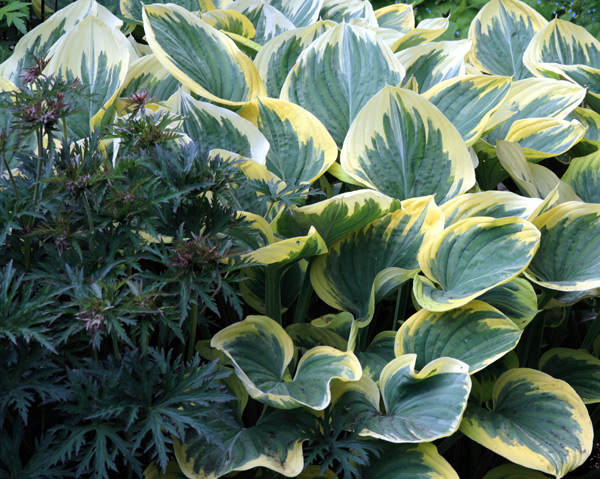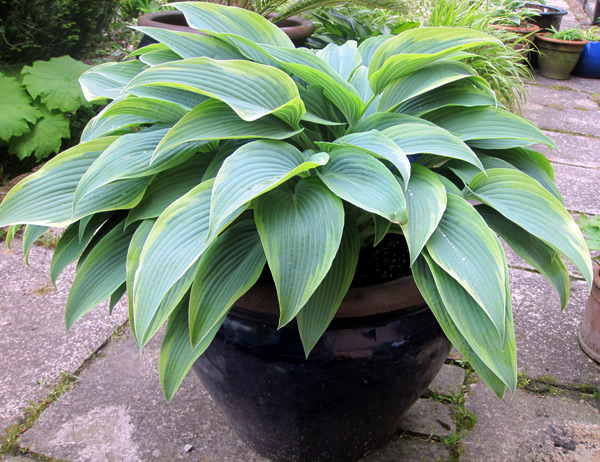Very popular in the United States, hostas struggle to gain a foothold in our gardens. Indeed, these plants are known for attracting slugs and are therefore often overlooked in favour of more robust plants. However, when it comes to robust plants, hostas are among the best for heavy soil. They are extremely cold-resistant and thrive in the darkest areas of the garden. So yes, the hosta is a thirsty plant, yes, the hosta is a greedy one, but no, the hosta is not necessarily devoured by slugs if the right conditions are provided. Here is our practical guide to failing with your hostas in 4 lessons:
Lesson 1: Plant hostas in dry conditions, and they will dry out.
It is common knowledge that hostas love shade, but it must be cool and even moist, not at the foot of trees where the bare soil cracks in summer. If nothing grows in the dark and dry part of your garden, hostas will do no better!
A possible variant of failure: plant your hostas in a very well-drained pot, and forget about it for a few weeks without watering in the garden... Guaranteed results! Hostas thrive in pots... in a rich, not overly drained mix, and with regular watering even during rainy periods. Indeed, the drying out of a potted plant is much, much faster than in the ground, and plants in cool soil require regular watering from spring to autumn.
For lazy and procrastinating gardeners, here’s another simple and elegant variant to kill your hostas: delay planting the lovely young plants you just acquired by leaving them in the garden for a few days, in the sun and without watering... They will simply dry out!
→ To fail with your hostas, plant them under trees or in pots, without ever watering them.
Lesson 2: Drain, drain to dry them out... They will dry out.
It is sometimes recommended to plant hostas in a heather soil bed, which is light and filtering. Indeed, heather soil can be an excellent medium for hydrangeas, rhododendrons, and camellias, but often it contains more peat than actual compost from decomposed heather, and when it dries out, this so-called "heather soil" is very difficult to rehydrate; water glides over it and does not penetrate.
→ To fail with your hostas, plant them in so-called heather soil or, even better, in poor and well-draining soil.
The foliage of the hosta here is used in contrast with that of Geranium pratense Midnight Reiter
Lesson 3: Open a slug bar
Plant a single hosta in the middle of a lawn or a bed, and you are announcing the imminent opening of a slug and snail bar. Yes, slugs love hosta leaves, and consequently, all garden gastropods will head straight for it, especially if it is small and frail. If a plant is isolated, if it is young, and if amphibians, birds, and hedgehogs are absent from the garden, then yes, your hostas will be devoured. You will see the leaves shrink, become holey, and if the slug population is sufficiently abundant, disappear completely, leaving only a resilient stub of stem.
→ To fail, plant a young isolated hosta in the middle of a large bare bed in a garden devoid of natural fauna or organic slug deterrents like ferramol.
→ Check out our article:"9 Slug-resistant Hostas"
Lesson 4: Throw away a healthy hosta that you think is dead!
Every autumn, we receive dozens of calls from customers who have just received their ordered hostas and remark, with varying degrees of annoyance, that they are not entirely satisfied to receive a dead hosta... And every early spring, we get calls from customers a bit surprised to find an empty pot instead of the friendly hosta that was supposed to be delivered to them. It also happens that our customers are dismayed to see their hosta, planted in autumn, not re-emerge.
So, we remind them that the hosta is perennial (which lives for many years and forms a large clump) but it is not evergreen. Its autumn foliage gradually dries out, taking on a greyish hue and hanging limply before disappearing... only to reappear late in spring, in April or even May... And we too have, during a spring clean-up, accidentally split a poor hosta snugly asleep under a few centimetres of soil.
If you have any doubts, a simple gesture at purchase, which applies to almost all deciduous perennials: remove the root ball from its pot and check the root condition. Hostas have large, fleshy white roots. Their presence allows you to quickly check the health of the lovely sleeper. In the garden, if you have doubts in spring, you can gently dig to find the hard stump or the beginning of the stem. But again, hostas are not afraid of the cold but have a heavy sleep: give them time to wake up!
→ To fail with your hostas, do not mark their location in the garden in autumn, and brutally kill it with a spade... Or angrily throw away the "empty" pot containing the plant asleep under a few centimetres of soil.
 In heavy soil, its structuring foliage allows for beautiful arrangements; it can be used in a mix of harmonious shades, here Hosta Patriot is associated with Montia sibirica and Brunnera Jack Frost.
In heavy soil, its structuring foliage allows for beautiful arrangements; it can be used in a mix of harmonious shades, here Hosta Patriot is associated with Montia sibirica and Brunnera Jack Frost.
Bonus tip for readers who have followed us this far: how not to make a hosta flower?
Some hostas, particularly the grandiflora variety, produce beautiful large fragrant flowers. If and only if they receive a bit of sun: in complete shade, even dense, your hostas will grow and offer you beautiful leaves. But, if they do not have one or two hours of sun per day, they will not flower.
→ To prevent a hosta from flowering, plant it in complete, dense shade.
If despite my words, you are tempted to grow hostas and neither your soil nor your climate is suitable, grow them in pots while monitoring watering. This is how I test them; some new varieties are very attractive but grow slowly or are real slug magnets. To avoid losing them, I grow them in the shade on my terrace so I can observe them closely, and when I tire of a variety, I plant it in the garden. Since the stump is mature, slugs may eat a few leaves but do not completely strip the plant of its foliage!

































Comments